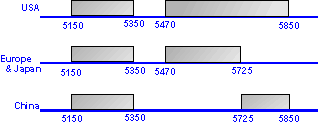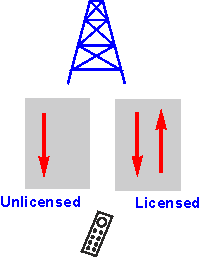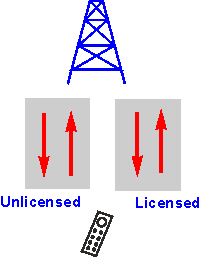LTE in unlicensed spectrum (LTE-U)
LTE-U is a proposal, originally developed by Qualcomm, for the use of the 4G LTE radio communications technology in unlicensed spectrum, such as the 5 GHz band used by 802.11a compliant Wi-Fi equipment. It will serve as an alternative to carrier-owned Wi-Fi hotspots.
LTE networks are carrying an increasing amount of data. Although cells can be made smaller to help accommodate this, it is not the complete solution and more spectrum is needed.
One approach is to use unlicensed spectrum alongside the licensed bands. Known in 3GPP as LTE-LAA – LTE License Assisted Access or more generally as LTE U – LTE Unlicensed, it enables access to unlicensed spectrum especially in the 5GHz ISM band.
LTE-U background
There is a considerable amount of unlicensed spectrum available around the globe. These bands are used globally to provide unlicensed access for short range radio transmissions. These bands, called ISM – Industrial, Scientific and Medical bands are allocated in different parts of the spectrum and are used for a wide variety of applications including microwave ovens, Wi-Fi, Bluetooth, and much more.
The frequency band of most interest for LTE-U, Unlicensed / LTE-LAA, License Assisted Access is the 5GHz band. Here there are several hundred MHz of spectrum bandwidth available, although the exact bands available depend upon the country in question.

5GHz bands for LTE-U / LTE-LAA
In addition to the basic frequency limits, the use of the 5GHz bands for applications such as LTE-U or LTE-LAA carries some regulatory requirements.
One of the main requirements for access to these frequencies is that of being able to coexist with other users of the band – a method of Clear Channel Assessment, CCA, or Listen Before Talk, LBT is required. This often means that instantaneous access may not always be available when LTE-U is being implemented.
Another requirements is that there are different power levels allowed dependent upon the country and the area of the band being used. Typically between 5150 and 5350 MHz there is a maximum power limit of 200 mW and operation is restricted to indoor use only, and the upper frequencies often allow power levels up to 1 W.
LTE-U / LTE-LAA basics
The use of LTE-U (Unlicensed) / LTE-LAA (License Assisted Access) was first introduced in Rel13 of the 3GPP standards. Essentially, LTE-U is built upon the carrier aggregation capability of LTE-Advanced that has been deployed since around 2013. Essentially Carrier aggregation seeks to increase the overall bandwidth available to a user equipment by enabling it to use more than one channel, either in the same band, or within another band.
There are several ways in which LTE-U can be deployed:
- Downlink only: This is the most basic form of LTE-U and it is similar in approach to some of the first LTE carrier aggregation deployments. In this the primary cell link is always located in the licensed spectrum bands.

Also when operating in this mode, the LTE eNodeB performs most of the necessary operations to ensure reliable operation is maintained and interference is not caused to other users by ensuring the channel is free.
- Uplink and downlink: Full TDD LTE-U operation with the user equipment having an uplink and downlink connection in the unlicensed spectrum requires the inclusion of more features.

- FDD / TDD aggregation: LTE-CA allows the use of carrier aggregation mixes between FDD and TDD. This provides for much greater levels of flexibility when selecting the band to be used with in unlicensed spectrum for LTE-LAA operation.
LTE-U relies on the existing core network for the backhaul, and other capabilities like security and authentication. As such no changes are needed to the core network. Some changes are needed to the base station so that it can accommodate the new frequencies and also incorporate the capabilities required to ensure proper sharing of the unlicensed frequencies. In addition to this, the handsets or UEs will need to have the new LTE-U / LTE-LAA capability incorporated into them so they can access LTE on these additional frequencies.
LTE-U / Wi-Fi coexistence
One of the great worries is that the use of LTE-U will swamp the 5GHz unlicensed band and that Wi-Fi using these frequencies will suffer along with other users. The LTE-U system is being designed to overcome this issue and using an listen before transmit, LBT solution, all users should be able to coexist without any undue levels of interference. There will be cases where LTE-U operation and Wi-Fi use different channels and under these circumstances there will be only minimal levels of interference. It is also possible to run LTE-U and Wi-Fi on the same channel. Under these circumstances both are able to operate, although with a lower data throughput. It is also possible to place a “fairness” algorithm into the eNodeB to ensure that the Wi-Fi signal is not unduly degraded and is still able to support a good data throughput.
LTE in Unlicensed spectrum (LTE-U)
LTE-U would allow cellphone carriers to boost coverage in their cellular networks, by using the unlicensed 5 GHz band already populated by Wi-Fi devices. T-Mobile and Verizon Wireless have indicated early interest in deploying such a system as soon as 2016. While cell providers ordinarily rely on the radio spectrum to which they have exclusive licenses, LTE-U would share space with Wi-Fi equipment already inhabiting that band – smartphones, laptops and tablets connecting to home broadband networks, free hotspots provided by businesses, and so on.
LTE-U is intended to let cell networks boost data speeds over short distances, without requiring the user to use a separate Wi-Fi network as they normally would. It differs from Wi-Fi calling; there remains a control channel using LTE, but all data (not just phone calls) flows over the unlicensed 5 GHz band, instead of the carrier’s frequencies.
For More Information
Please Contact Us
You must be logged in to post a comment.